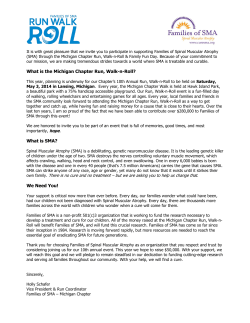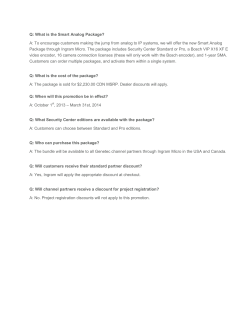
Interim Results of a Phase 2 Open-Label Study of ISIS-SMN
Interim Results of a Phase 2 Open-Label Study of ISIS-SMNRx in Patients with Infantile-onset (Type 1) Spinal Muscular Atrophy Finkel, R1; Chiriboga, C2; Vasjar, J3; Day, J4; Cook, D1; Cruz, R2; Montes, J2; De Vivo, D2; McMillan, L3; Watson, K4; Paulose, S4; Yamashita, M5; Alexander, K5; Norris, D5; Bennett, C.5; Bishop, K5 1 – Nemours Children’s Hospital; 2 – Columbia University Medical Center; 3 – University of Toronto Hospital for Sick Children; 4 – Stanford University Medical Center; 5 – Isis Pharmaceuticals, Inc. ISIS-SMNRx: Modulating Splicing of SMN2 to Increase Normal SMN Protein 2 Uniformly 2’-O-methoxyethyl modified (MOE) antisense drug HO O O S P O O Designed to correct the splicing disorder in SMN2, resulting in the production of fully functional SMN protein in model systems B O OCH3 O O B O OCH3 Provides a phenotypic and pathological benefit in mouse models of SMA and distributes broadly to spinal cord motor neurons in monkeys when delivered centrally * SMN2 Gene SMN2 Gene C to T C to T 1 2a 2b 1 2 3 2 3 4 4 5 5 6 6 7 8 8 SMN2 mRNA Defective Protein, missing exon 7 1 2a 2b 1 22 3 2 3 4 5 6 7 8 ISIS-SMNRx 4 5 6 7 8 SMN2 mRNA Functional Protein *(Hua et al., Genes Dev., 2010; Passini et al., Sci Transl Med, 2011; Hua et al., Nature, 2011) Type 1 Spinal Muscular Atrophy Highest Incidence, Most Severe Form of SMA 3 *Finkel et al. Neurology. 2014 Aug 26;83(9):810-7. **Rudnik-Schöneborn et al. Clin Genet. 2009 Aug;76(2):168-78. 3 Phase 2 Open-Label Study of ISIS-SMNRx in Patients with Infantile-onset (Type 1) Spinal Muscular Atrophy 4 Multiple doses given intrathecally as LP bolus injections in male and female infants with SMA <7 months of age who were not hypoxemic at screening - Study conducted at 4 clinical sites in North America, currently ongoing Primary endpoints: - Safety and tolerability - CSF and plasma drug level pharmacokinetics Exploratory efficacy endpoints include clinical outcomes related to SMA (survival and ventilation; CHOP-INTEND motor function; motor milestones) Dose Cohort n 6 mg equivalent 4 12 mg equivalent 16 Open Label Screening (≤21 days) SUBJECT DEMOGRAPHICS Male/Female Mean age at symptom onset (range) Mean age at enrollment (range) SMN2 Copy # Maintenance dosing once every 6 or 4 months Day 1 Day 15 Dose Dose 3 Month Dose 9 Month Dose 6 mg Cohort (n=4) 12 mg Cohort (n=16) 3/1 7 weeks (4 to 10) 9/7 9 weeks (3 to 22) 21 weeks (10 to 30) 20 weeks (5 to 30) All 2 copies 2 copies=12; 3 copies=2; not yet analyzed = 2 Safety/Tolerability Results (as of Sept 2, 2014) 5 Exposure includes 20 infants dosed with a total of 67 intrathecal injections (most have received 3-5 injections) ISIS-SMNRx has been well tolerated, with no safety concerns when given as multiple doses up to 12 mg equivalent - SAEs are consistent with severe SMA infant disease and not considered drug-related; majority of SAEs were related to respiratory infections - Adverse Events (non-SAEs) mostly mild or moderate in severity, only 1 mild AE considered related to drug - No potential Dose Limiting Toxicities reported - No drug-related changes on neurological exams - No clinically significant changes in CSF safety labs compared to pre-dose - No change in safety profile with repeated injections The LP injection procedure in SMA infants has been well tolerated and has been shown to be feasible with out sedation ISIS-SMNRx Phase 2 Study Subject Status (as of Sept. 2, 2014) 6 mg Cohort Efficacy Population1 Accidental Death Median event-free age on Sept 2 = 16.3 months * 12 mg Cohort Median event-free age on Sept 2 = 11.6 months Efficacy Population1 ** * ** 1 Per protocol efficacy population = subjects who receive 3 initial loading doses and Day 92 evaluation hours hours/day of ventilation continuously for ≥2 weeks, in the absence of an acute reversible illness 2 ≥16 *SMN2 copy number of 3; **SMN2 copy number not yet known; All other subjects have SMN2 copy number of 2 2 Kaplan-Meier Curves for Type 1 SMA Infants With 2 SMN2 Copies (Efficacy Population; Sept 2, 2014 data cut-off) ISIS-SMNRx-treated vs. Untreated SMA Infants from PNCR Natural History Study 7 Probability of Endpoint-free Survival 1.00 ISIS-SMNRx-treated Type 1 with 2 copies SMN2, n=14) Untreated PNCR Type 1 with 2 copies SMN2, n = 23)* 0.75 Most recent assessment 0.50 0.25 0.00 0 5 10 15 20 Age at Combined Endpoint (Months) *Finkel et al. Neurology. 2014 Aug 26;83(9):810-7 25 30 35 CHOP INTEND Infant Motor Function Test (Efficacy Population; Data cut-off Sept. 2, 2014) 8 SMA Type 1 infants in the PNCR study had a CHOP INTEND decline of 1.27 points/study year Majority of ISIS-SMNRx-treated infants saw increases in CHOP INTEND scores Mean change from baseline = 9.3 points (p=0.005) 14/16 patients had increases At the 12 mg dose level, increases were observed in most of patients at 3-6 months Mean change from baseline = 11.7 points (p=0.001) 11/12 patients had increases 6 mg Cohort 12 mg Cohort Mean change PNCR PNCR Achievement of Motor Milestones Observed (Efficacy Population; Baseline) Blue—6 mg, Red—12 mg 9 Head control Unable to maintain upright Wobbles All the time upright Sitting Cannot sit Sit with support at hips Props Stable sit Voluntary grasp No grasp Uses whole hand Index finger and thumb but immature grasp Pincer grasp Ability to kick (in supine) No kicking Kicks horizontally; legs do not lift Upward (vertically) Touches leg Rolling No rolling Rolling to side Prone to supine Supine to prone Crawling Does not lift head On elbow On outstretched hand Crawling flat on abdomen Standing Does not support weight Supports weight Stands with support Stands unaided Walking No walking Bouncing Cruising (holding on) Walking independently Pivots (rotates) Touches toes On hands and knees Incremental milestones achieved consistent with CHOP-INTEND score increases - 14/16 subjects exhibited improvements (3/4 at 6 mg; 11/12 at 12 mg) Achievement of Motor Milestones Observed (Efficacy Population; Data cut-off Sept 2, 2014) Blue—6 mg, Red—12 mg Incremental milestones achieved consistent with CHOP-INTEND score increases (14/16 subjects exhibited improvements - 3/4 at 6 mg; 11/12 at 12 mg) Description of Subjects Who Contributed to Mechanism of Action Analysis ISIS-SMNRx-treated SMA Infants Subject ID Dosing Cohort SMN2 Genes Doses Received* Time Since Last Dose Infant 1 6 mg 2 6 mg x 3 followed by 12 mg 6 months later 0.5 months Infant 2 12 mg 2 12 mg x 3 1.1 months Infant 3 12 mg 2 12 mg x 3 2.6 months *Doses adjusted based upon age to account for CSF and brain volume Non-SMA Subjects Untreated SMA Infants Subject ID SMN1, SMN2 Genes Subject ID SMN2 Genes Infant A 2, 2 Infant W 2 Infant B NA Infant X 2 Infant C 2, 1 Infant Y 2 Subject D NA Infant Z 2 All were between 5-16 months of age, except Subject D ISIS-SMNRx Distribution Throughout the Spinal Cord and Brain and in Neurons of SMA Infants 12 Cervical- Control Ab Shown is ISIS-SMNRx SMA Infant 3; similar results observed in other two ISIS-SMNRx SMA Infants Immunohistochemical staining confirms drug in all levels of spinal cord and in brain (brown staining is IHC for ISIS-SMNRx ASO) Lumbar Cord Thoracic Cord Cervical Cord Motor Cortex *ISIS-SMNRx in SC motor neurons indicated by red arrows, but also found in other neurons and glia Tissue Concentration of ISIS-SMNRx in Spinal Cord of Treated SMA Infants is Greater Than the Concentration That Produced Biological Activity in Animal Studies 13 ISIS-SMNRx µg/gm Quantitative Hybridization ELISA of Different Spinal Cord Segments Concentration range that produced biological activity in animal studies 1-10 µg/gm Tissue 1 Spinal Cord Segment: 2 Lumbar 3 1 2 3 Thoracic 1 2 3 Cervical ISIS-SMNRx Tx patient number Greater Amount of Full Length SMN2 mRNA is Observed in Thoracic Spinal Cord in ISIS-SMNRx-treated SMA Infants Compared to Untreated SMA Infants 14 Semi-Quantitative RT-PCR Analysis A B ISIS-SMNRx Tx SMA UnTx SMA Non SMA C W X Y Z 1 2 3 FL SMN2 6 Δ7 SMN2 6 7 8 SMN2 mRNA 8 8 0 6 0 %FulLength 4 0 2 0 0 % • • • Full Length by Group (Mean ± SD) Non SMA = 21.7 ± 3.8 Untreated SMA = 20.8 ± 5.6 ISIS SMNRx Tx = 57 ± 10.4 Greater Amount of Full Length SMN2 mRNA Observed in Tissues Analyzed from Different Spinal Cord and Brain Regions in ISISSMNRx-treated SMA Infants Compared to Untreated SMA Infants Semi-Quantitative RT-PCR Analysis L = Lumbar SC T = Thoracic SC C = Cervical SC MC = Motor Cortex Th = Thalamus ISIS-SMNRx Tx SMA Infants A C W Y T T T T 1 L T C 2 MC TH L T C 3 MC TH L T C MC TH FL SMN2 Δ7 SMN2 % Full Length SMN2 RNA Lumbar SC Thoracic SC Cervical SC Motor Cortex Thalamus A C W Y Non UnTx SMA SMA Infants Infants 1 2 3 ISIS-SMNRx Tx SMA Infants 6 6 7 8 8 Greater SMN Protein Observed in Thoracic Spinal Cord of ISIS-SMNRx Treated SMA Infants Compared to Untreated SMA Infants Semi-quantitative Immunofluorescence Staining for SMN Protein Non-SMA Subject Subject D UnTx SMA Infant Infant X SMN Protein = Red DAPI stain (for cell nuclei) = Blue ISIS-SMNRx Tx SMA Infant Infant 1 SMN Protein is Found in Neurons of ISIS-SMNRx-Treated SMA Infant in which ISIS-SMNRx is Present 17 Infant 1 Immunofluorescence Staining for SMN Protein and ISIS-SMNRx 2303 ISIS-SMNRx = Green SMN Protein = Red DAPI Stain (for nuclei) = Blue Conclusions and Implications 18 ISIS-SMNRx intrathecal injection has been well tolerated up to 12 mg given as multiple doses in infants with SMA Encouraging signs of efficacy observed in this open label study Increase in CHOP-INTEND motor function scores Incremental achievement of Infant Motor Milestones Survival/permanent ventilation compares favorably to that of Natural History studies Confirmation of drug delivery to cells in spinal cord and brain of SMA infants Evidence of increase in full-length SMN2 mRNA and increase in SMN protein in spinal cord of SMA infants These data informed the design of an ongoing Phase 3 registrationenabling study in infants with SMA Currently being conducted in US, Canada, EU, Asia/Pac and Japan Acknowledgements 19 Columbia University Sally Dunaway Jonathan Mara Louis Weimer Nemours Childrens Jenna Turner Stanford University Richard Gee University of Toronto Renee Haldenby Jennifer Boyd ISIS 396443-CS3A DSMB Walter Bradley, Chairperson Anne Connelly Priya Kishnani Barry Russman Isis Pharmaceuticals Matt Buck Gene Hung Katherine Kwoh John Madsen Laury Mignon Frank Rigo Eugene Schneider Margaret Whitely Biogen Idec SMA Foundation Families of SMA Johns Hopkins Charlotte Sumner David Valdivia The patients and families who participated in the study
© Copyright 2025










